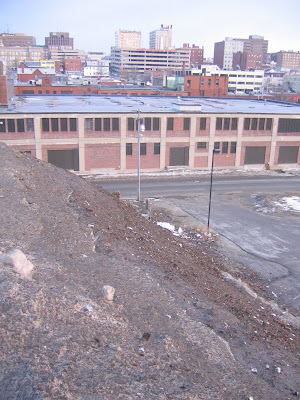The Gulf Coast Money Machines
The Ocean Star also has a great view across the harbor of a huge waterfront industrial area where construction companies rehab old drilling rigs. Maine readers may remember when Cianbro built a pair of these things on the Portland waterfront a few years ago, before they floated them off to punch holes in the seafloor near South America. The pictures I took do not do justice to how massive these things are.

These rigs are filled with extremely expensive equipment and very expensive labor. Offshore rig workers are highly-trained and willing to spend weeks at a time hundreds of miles out at sea, which, in today's labor market, means that they get paid more than Ishmael or Queequeg ever could have dreamed. Seeing models of rigs perched atop of 6,000-foot-deep underwater poles, or photographs of the elaborate fleet required to install a rig, plus the enormous rigs under construction across the harbor, all left the distinct impression that there is a stunning amount of American ingenuity and effort being devoted to getting oil out of the ground. And, as a corollary to that, there is a shit-ton of money being made.
Exxon-Mobil's $41 billion profits last year are just the tip of the iceberg: the big oil companies in turn pay trillions to other companies (many of them based in or near Houston) that specialize in exploration, underwater construction, geology, equipment manufacture, consulting, etcetera, etcetera.
One thing we couldn't help but notice on the oil rig museum was all the expensive-looking equipment with the "Halliburton" logo stamped on its side. And it was across the harbor, too, on a big building next to the oil rigs pictured above. Curse Dick Cheney all you want, but any time you buy gasoline, heating oil, or natural gas, you're inflating the old villain's ridiculously valuable stock options.

Above: the Ocean Star's drill rig, and (lower right) something very expensive from Halliburton.
With oil at over $100 a barrel, the oil rigs can essentially print their own money - and it's a lot more valuable than the cash coming out of the U.S. Mint. Knowing this made me a bit chagrinned that the oil rig museum, with all of its oil industry sponsors, still charged us $6 a person for admission. But it was definitely worth it.











